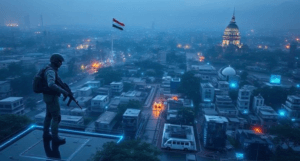India Strengthens National Security and Disaster Management with AI and Advanced Technology Partnerships
India is advancing its defence and disaster management capabilities through strategic technology collaborations. The first agreement between the Headquarters Integrated Defence Staff (HQ IDS) and the Department of Science and Technology (DST) aims to enhance defence research by merging military needs with scientific initiatives. DST will provide research facilities and expertise to develop advanced technologies for the Armed Forces, promoting self-reliance and strengthening national security.
The second collaboration, between the Centre for Development of Telematics (C-DOT) and IIT Delhi, focuses on creating an AI-powered chatbot for disaster management. This chatbot will assist in early warnings, emergency communication, and decision-making during crises, with features like multilingual translation and voice recognition. It will integrate with the National Disaster Management Authority’s platform to improve response times and effectiveness.
These initiatives reflect India’s commitment to using cutting-edge technology to enhance national security and disaster resilience, positioning the country as a global leader in technological solutions for crises and defence.

India Strengthens National Security and Disaster Management with AI and Advanced Technology Partnerships
India is taking significant steps to strengthen its defense systems and disaster response mechanisms by embracing modern technology and fostering partnerships with leading institutions. Two recent collaborations underscore the nation’s focus on safeguarding its security and improving emergency preparedness.
Boosting Defense Through Innovation
The first partnership involves the Headquarters Integrated Defence Staff (HQ IDS)—a body that coordinates defense strategies—and the Department of Science and Technology (DST). Together, they aim to bridge the gap between military needs and scientific research. By pooling resources, this partnership will leverage DST’s laboratories, research networks, and technical expertise to develop cutting-edge technologies tailored for the armed forces. For instance, advancements in areas like cybersecurity, drone technology, or surveillance systems could emerge from this synergy.
This initiative also encourages universities, startups, and industries to collaborate on defense-related projects. Such teamwork is expected to fast-track innovation, reduce reliance on imported military equipment, and support India’s vision of self-reliance (Atmanirbhar Bharat) in defense. Over time, these efforts will not only modernize the armed forces but also fortify national security against evolving threats.
AI Chatbot for Smarter Disaster Management
The second partnership, between the Centre for Development of Telematics (C-DOT)—a telecom research center—and the Indian Institute of Technology Delhi (IIT Delhi), focuses on creating an artificial intelligence (AI)-driven chatbot to manage disasters more effectively. Natural calamities like floods, cyclones, or earthquakes demand swift action, and this tool aims to streamline responses during such crises.
The chatbot will serve as a digital assistant for disaster management teams and the public. Key features include:
- Real-time alerts: Sending early warnings about impending disasters via SMS, apps, or social media.
- Multilingual support: Offering information in local languages to reach diverse populations, especially in rural areas.
- Voice commands: Allowing users to ask questions or report emergencies through speech, helpful for those with limited literacy.
- Coordination with authorities: Integrating with the National Disaster Management Authority’s (NDMA) systems to share data and allocate resources efficiently.
What makes this chatbot unique is its ability to learn from past incidents. By analyzing previous responses, the AI will refine its recommendations, improving future disaster plans. For example, during a flood, it could suggest evacuation routes based on real-time weather data or coordinate rescue teams using live updates. This tool aims to minimize damage, save lives, and ensure smoother recovery efforts.
Why These Steps Matter
Both initiatives reflect India’s proactive approach to addressing security and humanitarian challenges. By investing in defense technology, the country reduces vulnerabilities and strengthens its position as a global player in innovation. Simultaneously, the AI chatbot addresses the urgent need for faster, more inclusive disaster responses—a critical requirement as climate change intensifies natural disasters.
These collaborations also highlight the power of partnerships. When government bodies, academic institutions, and industries work together, they combine expertise, resources, and creativity to solve complex problems. For instance, IIT Delhi’s tech prowess complements C-DOT’s experience in communication systems, resulting in a practical solution for disaster management. Similarly, linking defense needs with scientific research ensures that advancements are both strategic and sustainable.
Looking Ahead
As India continues to adopt advanced technologies, these efforts are expected to create ripple effects. A self-reliant defense sector could spur job growth in tech and manufacturing, while the AI chatbot might inspire similar tools for healthcare or agriculture. Moreover, showcasing such innovations positions India as a leader in using technology for public welfare and security.
In essence, these projects are not just about immediate gains but building a resilient future. By prioritizing innovation and collaboration, India is equipping itself to handle emergencies with confidence and ensuring its defense capabilities meet global standards. For citizens, this translates into safer communities and a nation better prepared to face tomorrow’s challenges.
You must be logged in to post a comment.